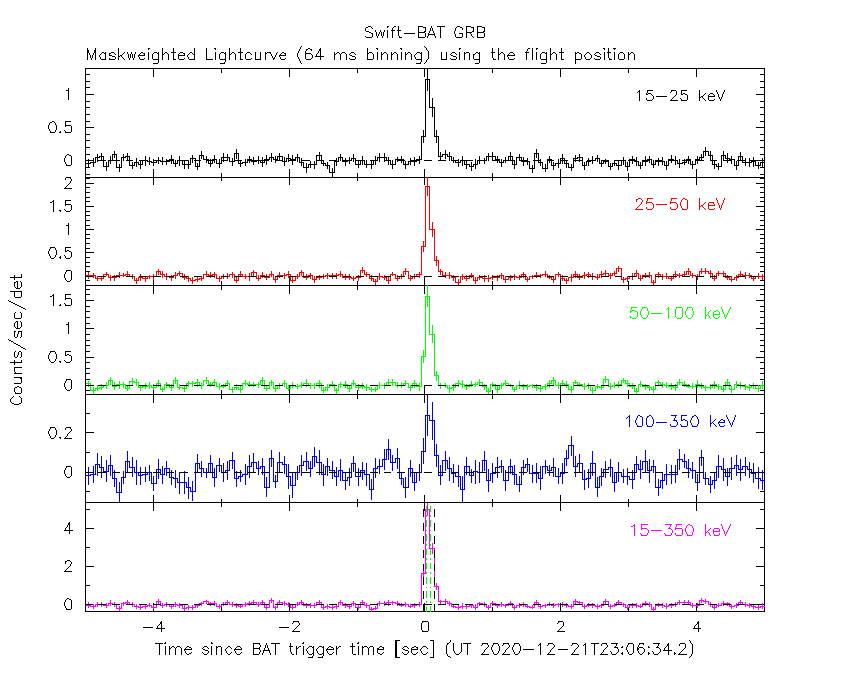
K.L. Page (U. Leicester), P.A. Evans (U. Leicester) and A.A. Breeveld (UCL-MSSL) for the Swift team
At 23:06:34 UT, the Swift Burst Alert Telescope (BAT) triggered and located GRB 201221D (trigger=1014037) (Page et al. GCN Circ. 29112). Swift slewed immediately to the burst. At the time of the trigger, the initial BAT position was 112° from the Sun (6.6 hours West) and 141° from the 50%-illuminated Moon. Table 1 contains the best reported positions from Swift, and the latest XRT position can be viewed at http://www.swift.ac.uk/xrt_positions.
de Ugarte Postigo et al. (GCN Circ. 29132) determined a redshift of 1.046 from GTC. Table 2 is a summary of GCN Circulars about this GRB from observatories other than Swift.
Standard analysis products for this burst are available at https://gcn.gsfc.nasa.gov/swift_gnd_ana.html.
As reported by Krimm et al. (GCN Circ. 29139),
the BAT ground-calculated position is RA, Dec = 171.055, 42.152 deg which is RA(J2000) = 1
The mask-weighted light curve (Figure 1) shows a single-peaked structure that starts at ~T-0.06 s, peaks at ~T+0.02 s, and ends at ~T+0.2 s.
The time-averaged spectrum from T-0.06 to T+0.17 s is best fit by a simple power-law model.
The power law index of the time-averaged spectrum is 1.56 ± 0.13.
The fluence in the 15-150 keV band is 3.9 ± 0.4 x 1
The results of the batgrbproduct analysis are available at https://gcn.gsfc.nasa.gov/notices_s/1014037/BA/.
Analysis of the initial XRT data was reported by Evans et al. (GCN Circ. 29124). We have analysed 11 ks of XRT data for GRB 201221D, from 97 s to 430.0 ks after the BAT trigger. The data are entirely in Photon Counting (PC) mode. The enhanced XRT position for this burst was given by Evans et al. (GCN Circ. 29113). There is evidence that the source may be fading, however we cannot constrain the decay at the current time
The results of the XRT team automatic analysis are available at http://www.swift.ac.uk/xrt_products/01014037.
The Swift/UVOT began settled observations of the field of GRB 201221D 92 s after the BAT trigger
(Breeveld and Page GCN Circ. 29129).
No optical afterglow consistent with the NOT or XRT position (Malesani et al. GCN Circ. 29117; Evans et al. GCN Circ. 29119) is detected in the initial UVOT exposures.
Table 3 gives preliminary
magnitudes using the UVOT photometric system
(Breeveld et al. 2011, AIP Conf. Proc., 1358, 373).
No correction has been made for the expected extinction in the Milky Way
corresponding to a reddening of

Figure 1. The BAT
mask-weighted light curve in the four individual and total
energy bands. The units are counts

Figure 2. The XRT light curve.
Any data from a crosshatched region are not included in the fit.
| RA (J2000) | Dec (J2000) | Error | Note | Reference |
|---|---|---|---|---|
| 1 |
+42°08'36.6" | 4.3" | XRT-final | UKSSDC |
| 1 |
+42°08'35.5" | 3.9" | XRT-enhanced | Evans et al. GCN Circ. 29119 |
| 1 |
+42°09'08.4" | 1.3' | BAT-refined | Krimm et al. GCN Circ. 29139 |
| Band | Authors | GCN Circ. | Subject | Observatory | Notes |
|---|---|---|---|---|---|
| Optical | Malesani and Knudstrup | 29117 | candidate optical counterpart from the NOT |
NOT | detection |
| Optical | Xu et al. | 29118 | Nanshan/NEXT early optical upper limit | Xinjiang Astro. Obs. | upper limits |
| Optical | Lipunov et al. | 29122 | Swift GRB 201221D: Global MASTER-Net observations report |
MASTER | |
| Optical | Jelinek et al. | 29125 | FRAM-ORM optical limit | FRAM | upper limits |
| Optical | de Ugarte Postigo et al. | 29132 | Short GRB201221D: High Redshift from OSIRIS/GTC |
GTC | redshift |
| Optical | Andreoni and Coughlin | 29141 | LCOGT upper limits | Las Cumbres Obs. Global Tele.Network | upper limits |
| Optical | Rastinejad et al. | 29142 | MMT MMIRS detection of marginally extended source |
MMT | detection |
| Optical | Dimple et al. | 29148 | 3.6m DOT optical observations | Devasthal Opt.Tel. | |
| Optical | Rossi | 29311 | near-infrared observation with LBT | LBT | |
| Radio | Huang et al. | 29144 | SMA submm observation | SMA | |
| Gamma-ray | Frederiks et al. | 29130 | Konus-Wind detection of GRB 201221D (short) |
Konus-Wind | |
| Gamma-ray | Hamburg et al. | 29140 | Fermi GBM detection | Fermi GBM | Fluence=1.076±0.046x1 (8 |
| Other | Dichiara et al. | 29128 | Lowell Discovery Telescope afterglow observations |
detection | |
| Other | Kilpatrick et al. | 29133 | Archival PS1 Imaging of the Putative Host Galaxy |
| Filter | Exp(s) | Mag | ||
|---|---|---|---|---|
| whit |
92 | 242 | 147 | >20.3 |
| 305 | 554 | 246 | >19.3 | |
| white | 4047 | 4247 | 197 | >21.0 |
| v | 634 | 4657 | 216 | >19.2 |
| u | 305 | 5110 | 282 | >19.4 |
| w1 | 684 | 5068 | 216 | >19.7 |
| m2 | 4663 | 4863 | 197 | >19.5 |
| w2 | 4253 | 4453 | 197 | >19.9 |
Table 3. UVOT observations reported by Breeveld and Page (GCN Circ. 29129). The start and stop times of the exposures are given in seconds since the BAT trigger. The preliminary 3-σ upper limits are given. No correction has been made for extinction in the Milky Way.
January 18, 2021